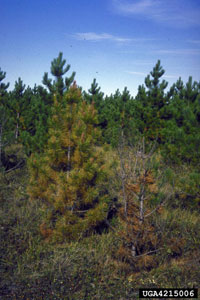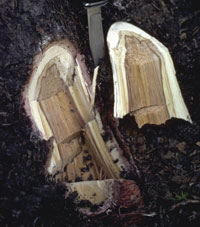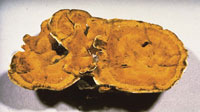Extension > Garden > Diagnose a problem > What's wrong with my plant? > Evergreen Trees and Shrubs > Spruce > Tree breaks or falls over
Spruce > Whole tree> Tree breaks or falls over
1 of 2
Armillaria root rot
Armillaria spp
- Infected trees have poor growth, dead branches in the upper canopy, browning needles, may produce an abundant crop of cones, and eventually die
- Clusters of honey-colored mushrooms may grow at the base of the tree in fall
- Flat white sheets of fungal mycelia (mycelia fans) grow between the bark and sapwood at the base of infected trees
- Thick black, shoestring-like fungal strands sometimes grow in a net on infected trees and in the soil around the base of the tree
- The base of the tree just below the soil surface may be encrusted in resin
- Wood is decayed, white, soft and stringy and may extend from the base of the tree well up into the trunk; trees frequently break or fall over in storms
- More information on Armillaria root rot
2 of 2
Tomentosus root rot
Inonotus tomentosus
- Heartwood of infected roots and trunks is initially reddish brown
- As infection continues white pocket rot develops; decayed wood has elongated pockets or pits, and may appear honeycomb-like in cross section
- Infected trees have reduced growth and thin canopies, produce large amounts of cones and eventually die
- Infected trees frequently break or lodge during storms
- Mushrooms that are velvety brown above and porous and buff colored below appear around the base of the tree in late summer
- More information on Tomentosus root rot









